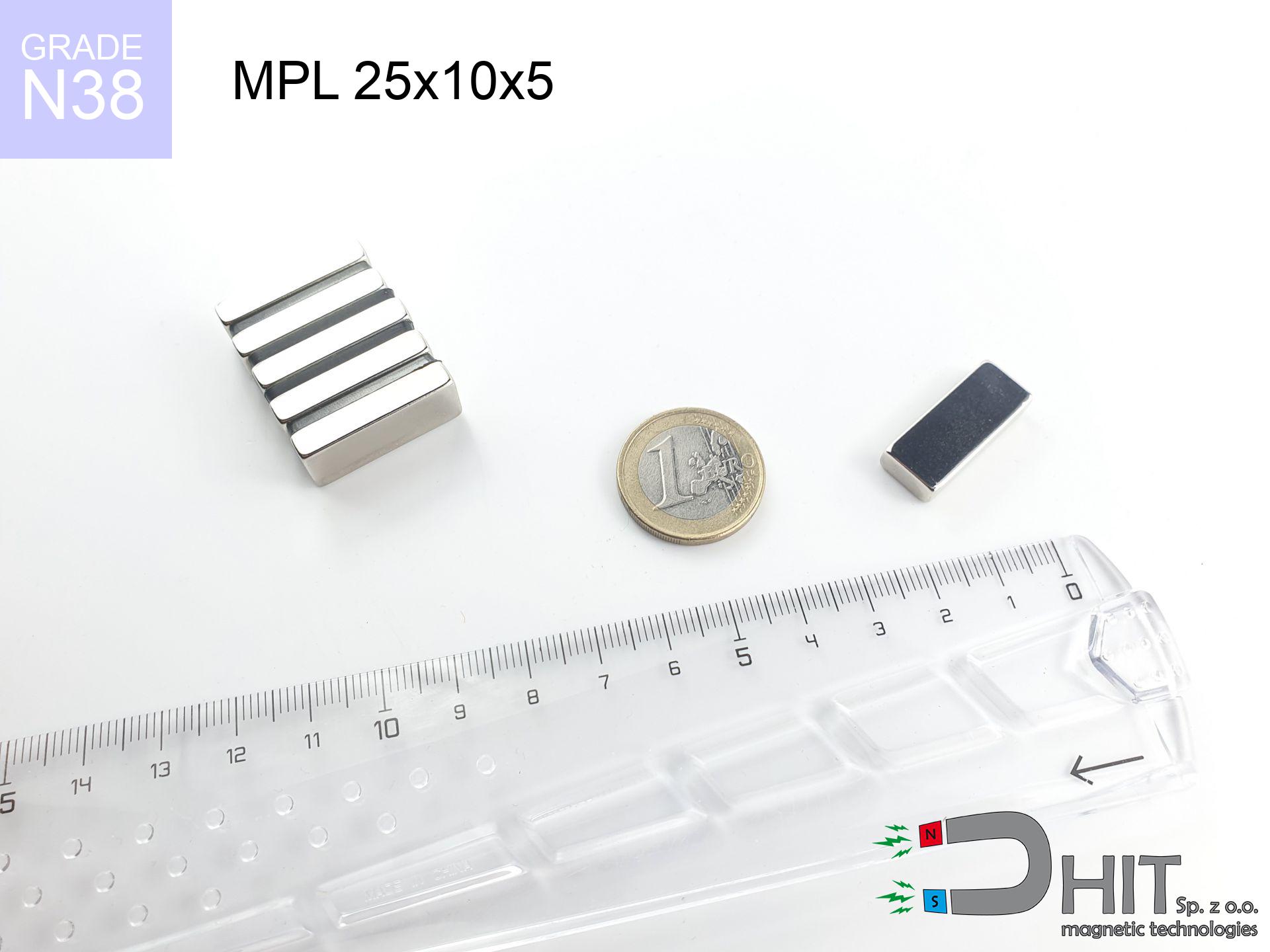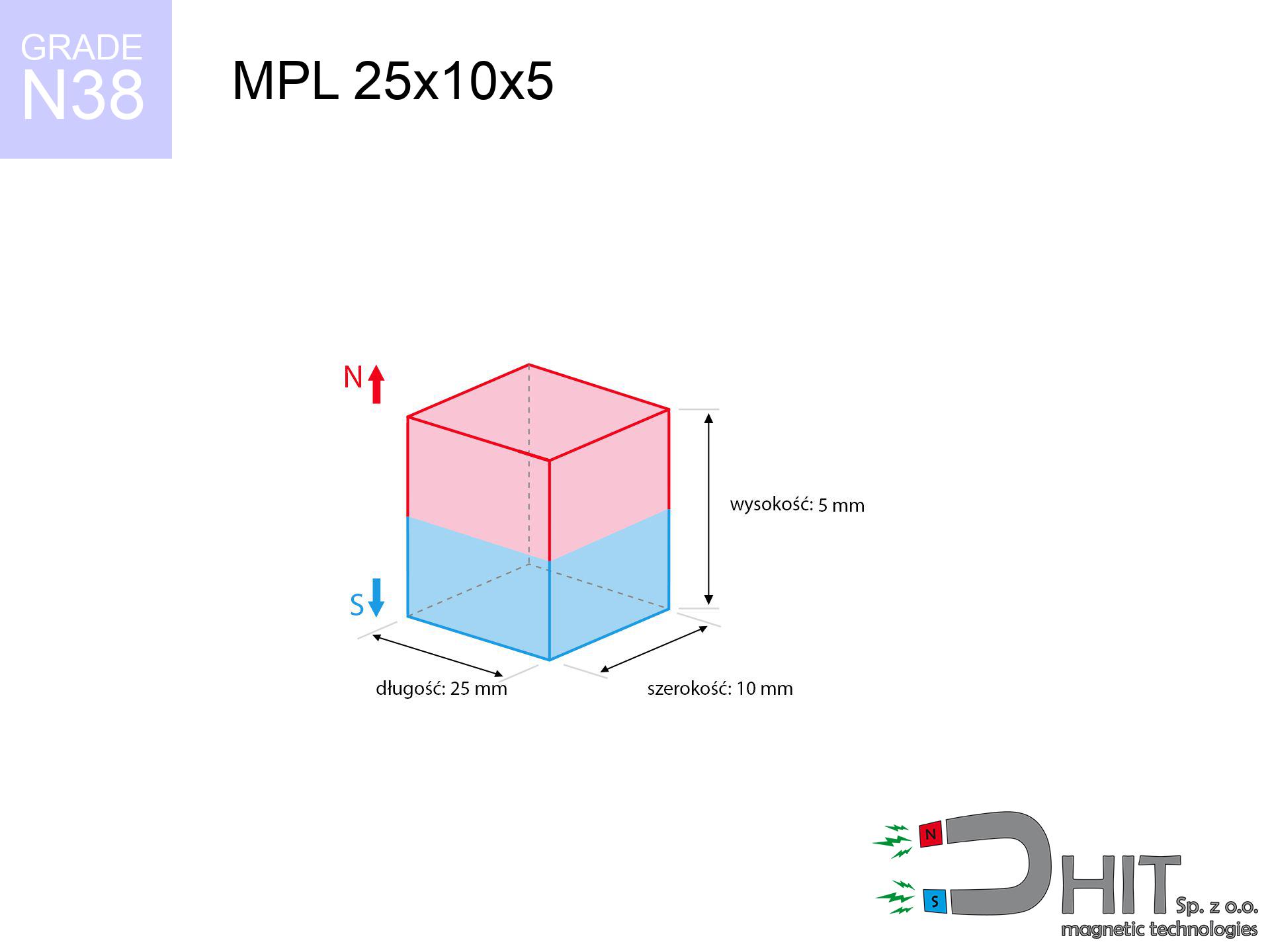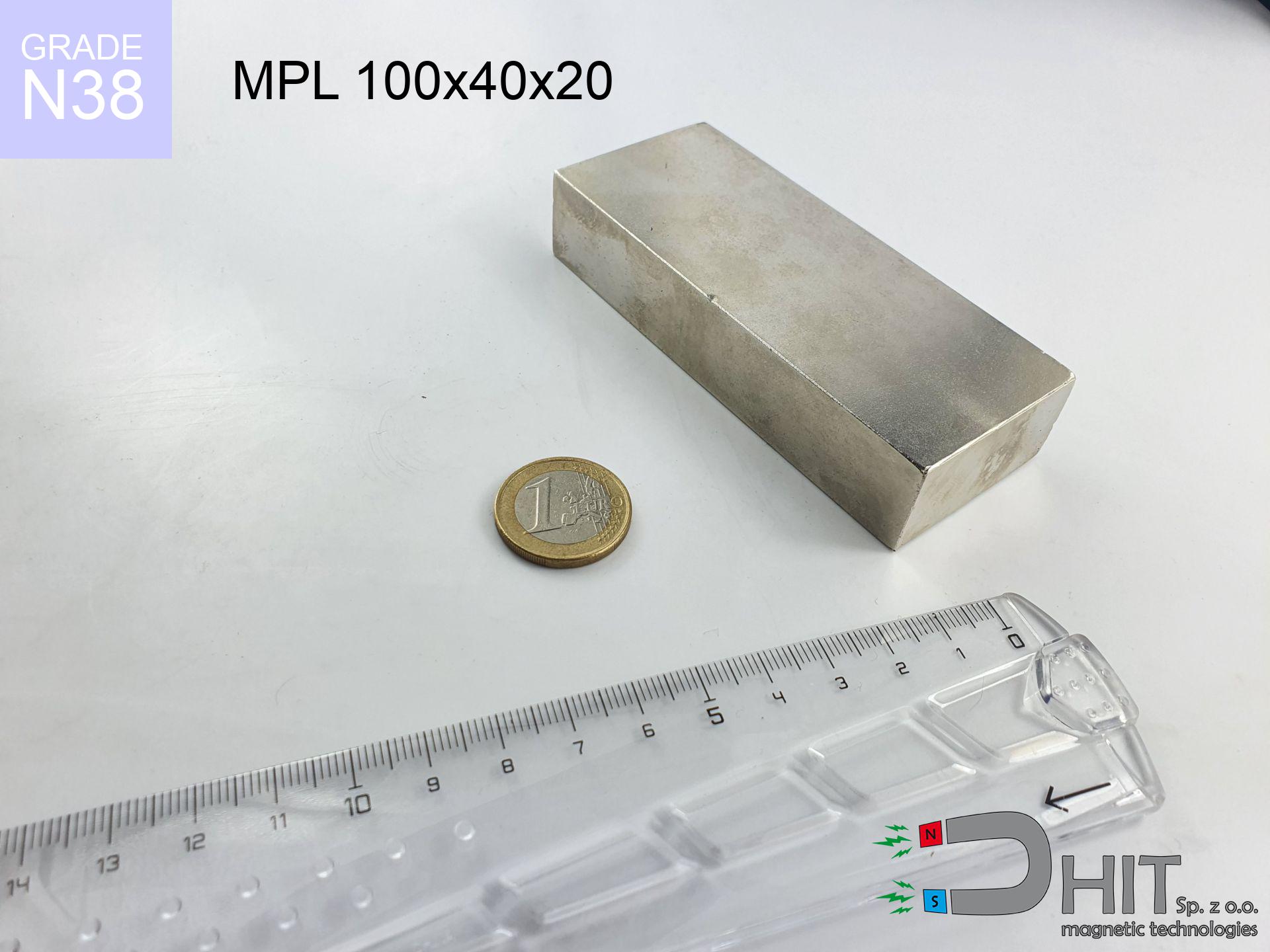MPL 25x10x5 / N38 - lamellar magnet
lamellar magnet
Catalog no 020135
GTIN/EAN: 5906301811411
length
25 mm [±0,1 mm]
Width
10 mm [±0,1 mm]
Height
5 mm [±0,1 mm]
Weight
9.38 g
Magnetization Direction
↑ axial
Load capacity
7.49 kg / 73.45 N
Magnetic Induction
337.05 mT / 3371 Gs
Coating
[NiCuNi] Nickel
4.66 ZŁ with VAT / pcs + price for transport
3.79 ZŁ net + 23% VAT / pcs
bulk discounts:
Need more?
Call us now
+48 22 499 98 98
alternatively contact us by means of
our online form
the contact form page.
Parameters as well as shape of magnetic components can be reviewed using our
power calculator.
Orders placed before 14:00 will be shipped the same business day.
Technical of the product - MPL 25x10x5 / N38 - lamellar magnet
Specification / characteristics - MPL 25x10x5 / N38 - lamellar magnet
| properties | values |
|---|---|
| Cat. no. | 020135 |
| GTIN/EAN | 5906301811411 |
| Production/Distribution | Dhit sp. z o.o. |
| Country of origin | Poland / China / Germany |
| Customs code | 85059029 |
| length | 25 mm [±0,1 mm] |
| Width | 10 mm [±0,1 mm] |
| Height | 5 mm [±0,1 mm] |
| Weight | 9.38 g |
| Magnetization Direction | ↑ axial |
| Load capacity ~ ? | 7.49 kg / 73.45 N |
| Magnetic Induction ~ ? | 337.05 mT / 3371 Gs |
| Coating | [NiCuNi] Nickel |
| Manufacturing Tolerance | ±0.1 mm |
Magnetic properties of material N38
| properties | values | units |
|---|---|---|
| remenance Br [min. - max.] ? | 12.2-12.6 | kGs |
| remenance Br [min. - max.] ? | 1220-1260 | mT |
| coercivity bHc ? | 10.8-11.5 | kOe |
| coercivity bHc ? | 860-915 | kA/m |
| actual internal force iHc | ≥ 12 | kOe |
| actual internal force iHc | ≥ 955 | kA/m |
| energy density [min. - max.] ? | 36-38 | BH max MGOe |
| energy density [min. - max.] ? | 287-303 | BH max KJ/m |
| max. temperature ? | ≤ 80 | °C |
Physical properties of sintered neodymium magnets Nd2Fe14B at 20°C
| properties | values | units |
|---|---|---|
| Vickers hardness | ≥550 | Hv |
| Density | ≥7.4 | g/cm3 |
| Curie Temperature TC | 312 - 380 | °C |
| Curie Temperature TF | 593 - 716 | °F |
| Specific resistance | 150 | μΩ⋅cm |
| Bending strength | 250 | MPa |
| Compressive strength | 1000~1100 | MPa |
| Thermal expansion parallel (∥) to orientation (M) | (3-4) x 10-6 | °C-1 |
| Thermal expansion perpendicular (⊥) to orientation (M) | -(1-3) x 10-6 | °C-1 |
| Young's modulus | 1.7 x 104 | kg/mm² |
Engineering simulation of the product - report
These information constitute the outcome of a mathematical calculation. Results rely on models for the material Nd2Fe14B. Actual performance might slightly differ. Use these data as a supplementary guide during assembly planning.
Table 1: Static pull force (force vs distance) - characteristics
MPL 25x10x5 / N38
| Distance (mm) | Induction (Gauss) / mT | Pull Force (kg/lbs/g/N) | Risk Status |
|---|---|---|---|
| 0 mm |
3369 Gs
336.9 mT
|
7.49 kg / 16.51 lbs
7490.0 g / 73.5 N
|
medium risk |
| 1 mm |
2932 Gs
293.2 mT
|
5.67 kg / 12.51 lbs
5673.2 g / 55.7 N
|
medium risk |
| 2 mm |
2479 Gs
247.9 mT
|
4.06 kg / 8.94 lbs
4056.9 g / 39.8 N
|
medium risk |
| 3 mm |
2065 Gs
206.5 mT
|
2.81 kg / 6.21 lbs
2814.7 g / 27.6 N
|
medium risk |
| 5 mm |
1419 Gs
141.9 mT
|
1.33 kg / 2.93 lbs
1328.6 g / 13.0 N
|
weak grip |
| 10 mm |
603 Gs
60.3 mT
|
0.24 kg / 0.53 lbs
240.3 g / 2.4 N
|
weak grip |
| 15 mm |
296 Gs
29.6 mT
|
0.06 kg / 0.13 lbs
57.8 g / 0.6 N
|
weak grip |
| 20 mm |
162 Gs
16.2 mT
|
0.02 kg / 0.04 lbs
17.4 g / 0.2 N
|
weak grip |
| 30 mm |
62 Gs
6.2 mT
|
0.00 kg / 0.01 lbs
2.5 g / 0.0 N
|
weak grip |
| 50 mm |
16 Gs
1.6 mT
|
0.00 kg / 0.00 lbs
0.2 g / 0.0 N
|
weak grip |
Table 2: Slippage capacity (vertical surface)
MPL 25x10x5 / N38
| Distance (mm) | Friction coefficient | Pull Force (kg/lbs/g/N) |
|---|---|---|
| 0 mm | Stal (~0.2) |
1.50 kg / 3.30 lbs
1498.0 g / 14.7 N
|
| 1 mm | Stal (~0.2) |
1.13 kg / 2.50 lbs
1134.0 g / 11.1 N
|
| 2 mm | Stal (~0.2) |
0.81 kg / 1.79 lbs
812.0 g / 8.0 N
|
| 3 mm | Stal (~0.2) |
0.56 kg / 1.24 lbs
562.0 g / 5.5 N
|
| 5 mm | Stal (~0.2) |
0.27 kg / 0.59 lbs
266.0 g / 2.6 N
|
| 10 mm | Stal (~0.2) |
0.05 kg / 0.11 lbs
48.0 g / 0.5 N
|
| 15 mm | Stal (~0.2) |
0.01 kg / 0.03 lbs
12.0 g / 0.1 N
|
| 20 mm | Stal (~0.2) |
0.00 kg / 0.01 lbs
4.0 g / 0.0 N
|
| 30 mm | Stal (~0.2) |
0.00 kg / 0.00 lbs
0.0 g / 0.0 N
|
| 50 mm | Stal (~0.2) |
0.00 kg / 0.00 lbs
0.0 g / 0.0 N
|
Table 3: Vertical assembly (sliding) - vertical pull
MPL 25x10x5 / N38
| Surface type | Friction coefficient / % Mocy | Max load (kg/lbs/g/N) |
|---|---|---|
| Raw steel |
µ = 0.3
30% Nominalnej Siły
|
2.25 kg / 4.95 lbs
2247.0 g / 22.0 N
|
| Painted steel (standard) |
µ = 0.2
20% Nominalnej Siły
|
1.50 kg / 3.30 lbs
1498.0 g / 14.7 N
|
| Oily/slippery steel |
µ = 0.1
10% Nominalnej Siły
|
0.75 kg / 1.65 lbs
749.0 g / 7.3 N
|
| Magnet with anti-slip rubber |
µ = 0.5
50% Nominalnej Siły
|
3.75 kg / 8.26 lbs
3745.0 g / 36.7 N
|
Table 4: Steel thickness (saturation) - sheet metal selection
MPL 25x10x5 / N38
| Steel thickness (mm) | % power | Real pull force (kg/lbs/g/N) |
|---|---|---|
| 0.5 mm |
|
0.75 kg / 1.65 lbs
749.0 g / 7.3 N
|
| 1 mm |
|
1.87 kg / 4.13 lbs
1872.5 g / 18.4 N
|
| 2 mm |
|
3.75 kg / 8.26 lbs
3745.0 g / 36.7 N
|
| 3 mm |
|
5.62 kg / 12.38 lbs
5617.5 g / 55.1 N
|
| 5 mm |
|
7.49 kg / 16.51 lbs
7490.0 g / 73.5 N
|
| 10 mm |
|
7.49 kg / 16.51 lbs
7490.0 g / 73.5 N
|
| 11 mm |
|
7.49 kg / 16.51 lbs
7490.0 g / 73.5 N
|
| 12 mm |
|
7.49 kg / 16.51 lbs
7490.0 g / 73.5 N
|
Table 5: Thermal stability (material behavior) - thermal limit
MPL 25x10x5 / N38
| Ambient temp. (°C) | Power loss | Remaining pull (kg/lbs/g/N) | Status |
|---|---|---|---|
| 20 °C | 0.0% |
7.49 kg / 16.51 lbs
7490.0 g / 73.5 N
|
OK |
| 40 °C | -2.2% |
7.33 kg / 16.15 lbs
7325.2 g / 71.9 N
|
OK |
| 60 °C | -4.4% |
7.16 kg / 15.79 lbs
7160.4 g / 70.2 N
|
|
| 80 °C | -6.6% |
7.00 kg / 15.42 lbs
6995.7 g / 68.6 N
|
|
| 100 °C | -28.8% |
5.33 kg / 11.76 lbs
5332.9 g / 52.3 N
|
Table 6: Two magnets (attraction) - field range
MPL 25x10x5 / N38
| Gap (mm) | Attraction (kg/lbs) (N-S) | Lateral Force (kg/lbs/g/N) | Repulsion (kg/lbs) (N-N) |
|---|---|---|---|
| 0 mm |
17.49 kg / 38.57 lbs
4 785 Gs
|
2.62 kg / 5.78 lbs
2624 g / 25.7 N
|
N/A |
| 1 mm |
15.37 kg / 33.89 lbs
6 316 Gs
|
2.31 kg / 5.08 lbs
2306 g / 22.6 N
|
13.84 kg / 30.50 lbs
~0 Gs
|
| 2 mm |
13.25 kg / 29.21 lbs
5 864 Gs
|
1.99 kg / 4.38 lbs
1987 g / 19.5 N
|
11.92 kg / 26.29 lbs
~0 Gs
|
| 3 mm |
11.26 kg / 24.83 lbs
5 407 Gs
|
1.69 kg / 3.72 lbs
1690 g / 16.6 N
|
10.14 kg / 22.35 lbs
~0 Gs
|
| 5 mm |
7.91 kg / 17.44 lbs
4 531 Gs
|
1.19 kg / 2.62 lbs
1187 g / 11.6 N
|
7.12 kg / 15.70 lbs
~0 Gs
|
| 10 mm |
3.10 kg / 6.84 lbs
2 838 Gs
|
0.47 kg / 1.03 lbs
465 g / 4.6 N
|
2.79 kg / 6.16 lbs
~0 Gs
|
| 20 mm |
0.56 kg / 1.24 lbs
1 207 Gs
|
0.08 kg / 0.19 lbs
84 g / 0.8 N
|
0.51 kg / 1.11 lbs
~0 Gs
|
| 50 mm |
0.01 kg / 0.03 lbs
194 Gs
|
0.00 kg / 0.00 lbs
2 g / 0.0 N
|
0.01 kg / 0.03 lbs
~0 Gs
|
| 60 mm |
0.01 kg / 0.01 lbs
124 Gs
|
0.00 kg / 0.00 lbs
1 g / 0.0 N
|
0.00 kg / 0.00 lbs
~0 Gs
|
| 70 mm |
0.00 kg / 0.01 lbs
84 Gs
|
0.00 kg / 0.00 lbs
0 g / 0.0 N
|
0.00 kg / 0.00 lbs
~0 Gs
|
| 80 mm |
0.00 kg / 0.00 lbs
59 Gs
|
0.00 kg / 0.00 lbs
0 g / 0.0 N
|
0.00 kg / 0.00 lbs
~0 Gs
|
| 90 mm |
0.00 kg / 0.00 lbs
43 Gs
|
0.00 kg / 0.00 lbs
0 g / 0.0 N
|
0.00 kg / 0.00 lbs
~0 Gs
|
| 100 mm |
0.00 kg / 0.00 lbs
32 Gs
|
0.00 kg / 0.00 lbs
0 g / 0.0 N
|
0.00 kg / 0.00 lbs
~0 Gs
|
Table 7: Protective zones (electronics) - precautionary measures
MPL 25x10x5 / N38
| Object / Device | Limit (Gauss) / mT | Safe distance |
|---|---|---|
| Pacemaker | 5 Gs (0.5 mT) | 8.0 cm |
| Hearing aid | 10 Gs (1.0 mT) | 6.0 cm |
| Mechanical watch | 20 Gs (2.0 mT) | 5.0 cm |
| Mobile device | 40 Gs (4.0 mT) | 4.0 cm |
| Remote | 50 Gs (5.0 mT) | 3.5 cm |
| Payment card | 400 Gs (40.0 mT) | 1.5 cm |
| HDD hard drive | 600 Gs (60.0 mT) | 1.5 cm |
Table 8: Impact energy (cracking risk) - warning
MPL 25x10x5 / N38
| Start from (mm) | Speed (km/h) | Energy (J) | Predicted outcome |
|---|---|---|---|
| 10 mm |
29.06 km/h
(8.07 m/s)
|
0.31 J | |
| 30 mm |
49.37 km/h
(13.71 m/s)
|
0.88 J | |
| 50 mm |
63.73 km/h
(17.70 m/s)
|
1.47 J | |
| 100 mm |
90.12 km/h
(25.03 m/s)
|
2.94 J |
Table 9: Corrosion resistance
MPL 25x10x5 / N38
| Technical parameter | Value / Description |
|---|---|
| Coating type | [NiCuNi] Nickel |
| Layer structure | Nickel - Copper - Nickel |
| Layer thickness | 10-20 µm |
| Salt spray test (SST) ? | 24 h |
| Recommended environment | Indoors only (dry) |
Table 10: Electrical data (Flux)
MPL 25x10x5 / N38
| Parameter | Value | SI Unit / Description |
|---|---|---|
| Magnetic Flux | 8 245 Mx | 82.5 µWb |
| Pc Coefficient | 0.38 | Low (Flat) |
Table 11: Physics of underwater searching
MPL 25x10x5 / N38
| Environment | Effective steel pull | Effect |
|---|---|---|
| Air (land) | 7.49 kg | Standard |
| Water (riverbed) |
8.58 kg
(+1.09 kg buoyancy gain)
|
+14.5% |
1. Vertical hold
*Warning: On a vertical wall, the magnet retains just a fraction of its perpendicular strength.
2. Plate thickness effect
*Thin metal sheet (e.g. 0.5mm PC case) drastically weakens the holding force.
3. Temperature resistance
*For N38 material, the max working temp is 80°C.
4. Demagnetization curve and operating point (B-H)
chart generated for the permeance coefficient Pc (Permeance Coefficient) = 0.38
The chart above illustrates the magnetic characteristics of the material within the second quadrant of the hysteresis loop. The solid red line represents the demagnetization curve (material potential), while the dashed blue line is the load line based on the magnet's geometry. The Pc (Permeance Coefficient), also known as the load line slope, is a dimensionless value that describes the relationship between the magnet's shape and its magnetic stability. The intersection of these two lines (the black dot) is the operating point — it determines the actual magnetic flux density generated by the magnet in this specific configuration. A higher Pc value means the magnet is more 'slender' (tall relative to its area), resulting in a higher operating point and better resistance to irreversible demagnetization caused by external fields or temperature. A value of 0.42 is relatively low (typical for flat magnets), meaning the operating point is closer to the 'knee' of the curve — caution is advised when operating at temperatures near the maximum limit to avoid strength loss.
Material specification
| iron (Fe) | 64% – 68% |
| neodymium (Nd) | 29% – 32% |
| boron (B) | 1.1% – 1.2% |
| dysprosium (Dy) | 0.5% – 2.0% |
| coating (Ni-Cu-Ni) | < 0.05% |
Environmental data
| recyclability (EoL) | 100% |
| recycled raw materials | ~10% (pre-cons) |
| carbon footprint | low / zredukowany |
| waste code (EWC) | 16 02 16 |
See also products
Strengths and weaknesses of neodymium magnets.
Benefits
- They retain attractive force for nearly 10 years – the loss is just ~1% (based on simulations),
- They are resistant to demagnetization induced by external disturbances,
- The use of an metallic finish of noble metals (nickel, gold, silver) causes the element to have aesthetics,
- Magnetic induction on the top side of the magnet turns out to be maximum,
- Made from properly selected components, these magnets show impressive resistance to high heat, enabling them to function (depending on their form) at temperatures up to 230°C and above...
- Possibility of custom modeling as well as adapting to complex applications,
- Significant place in innovative solutions – they are utilized in data components, electromotive mechanisms, precision medical tools, also technologically advanced constructions.
- Compactness – despite small sizes they offer powerful magnetic field, making them ideal for precision applications
Weaknesses
- At strong impacts they can break, therefore we advise placing them in steel cases. A metal housing provides additional protection against damage, as well as increases the magnet's durability.
- Neodymium magnets lose their strength under the influence of heating. As soon as 80°C is exceeded, many of them start losing their power. Therefore, we recommend our special magnets marked [AH], which maintain stability even at temperatures up to 230°C
- When exposed to humidity, magnets usually rust. For applications outside, it is recommended to use protective magnets, such as those in rubber or plastics, which prevent oxidation and corrosion.
- We recommend cover - magnetic mechanism, due to difficulties in creating nuts inside the magnet and complex forms.
- Health risk resulting from small fragments of magnets are risky, if swallowed, which gains importance in the context of child health protection. It is also worth noting that small components of these magnets can disrupt the diagnostic process medical after entering the body.
- With large orders the cost of neodymium magnets is a challenge,
Pull force analysis
Maximum magnetic pulling force – what contributes to it?
- with the contact of a sheet made of low-carbon steel, ensuring full magnetic saturation
- whose transverse dimension is min. 10 mm
- with a plane perfectly flat
- without the slightest insulating layer between the magnet and steel
- during detachment in a direction perpendicular to the mounting surface
- at room temperature
What influences lifting capacity in practice
- Air gap (betwixt the magnet and the plate), because even a tiny distance (e.g. 0.5 mm) results in a reduction in lifting capacity by up to 50% (this also applies to paint, corrosion or dirt).
- Force direction – declared lifting capacity refers to detachment vertically. When slipping, the magnet exhibits significantly lower power (often approx. 20-30% of maximum force).
- Element thickness – for full efficiency, the steel must be sufficiently thick. Thin sheet restricts the attraction force (the magnet "punches through" it).
- Metal type – different alloys reacts the same. Alloy additives weaken the interaction with the magnet.
- Surface structure – the more even the surface, the larger the contact zone and stronger the hold. Unevenness creates an air distance.
- Heat – neodymium magnets have a negative temperature coefficient. When it is hot they lose power, and at low temperatures they can be stronger (up to a certain limit).
Lifting capacity was assessed using a steel plate with a smooth surface of optimal thickness (min. 20 mm), under perpendicular detachment force, in contrast under parallel forces the holding force is lower. Additionally, even a slight gap between the magnet’s surface and the plate decreases the load capacity.
Safety rules for work with neodymium magnets
Medical interference
Individuals with a ICD have to keep an absolute distance from magnets. The magnetism can stop the functioning of the implant.
Adults only
NdFeB magnets are not toys. Eating multiple magnets may result in them connecting inside the digestive tract, which constitutes a critical condition and necessitates urgent medical intervention.
Nickel allergy
Studies show that the nickel plating (the usual finish) is a potent allergen. If you have an allergy, avoid touching magnets with bare hands and select encased magnets.
Respect the power
Exercise caution. Rare earth magnets attract from a distance and connect with huge force, often quicker than you can move away.
Data carriers
Device Safety: Strong magnets can damage data carriers and sensitive devices (pacemakers, hearing aids, mechanical watches).
Risk of cracking
Neodymium magnets are sintered ceramics, meaning they are fragile like glass. Impact of two magnets will cause them shattering into small pieces.
Heat sensitivity
Standard neodymium magnets (grade N) lose power when the temperature surpasses 80°C. Damage is permanent.
Impact on smartphones
An intense magnetic field interferes with the operation of compasses in smartphones and navigation systems. Do not bring magnets close to a device to avoid breaking the sensors.
Bodily injuries
Big blocks can crush fingers instantly. Under no circumstances put your hand between two strong magnets.
Fire risk
Fire hazard: Neodymium dust is explosive. Do not process magnets without safety gear as this risks ignition.









